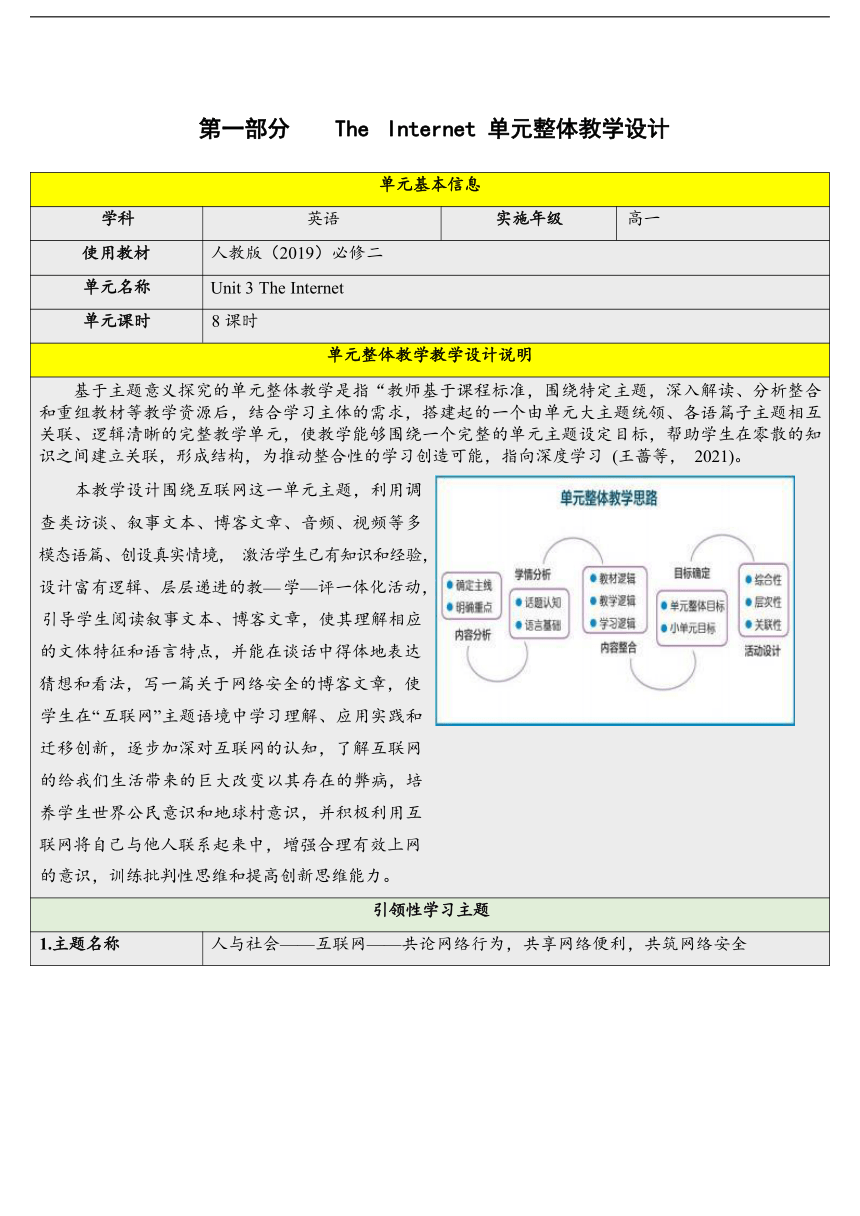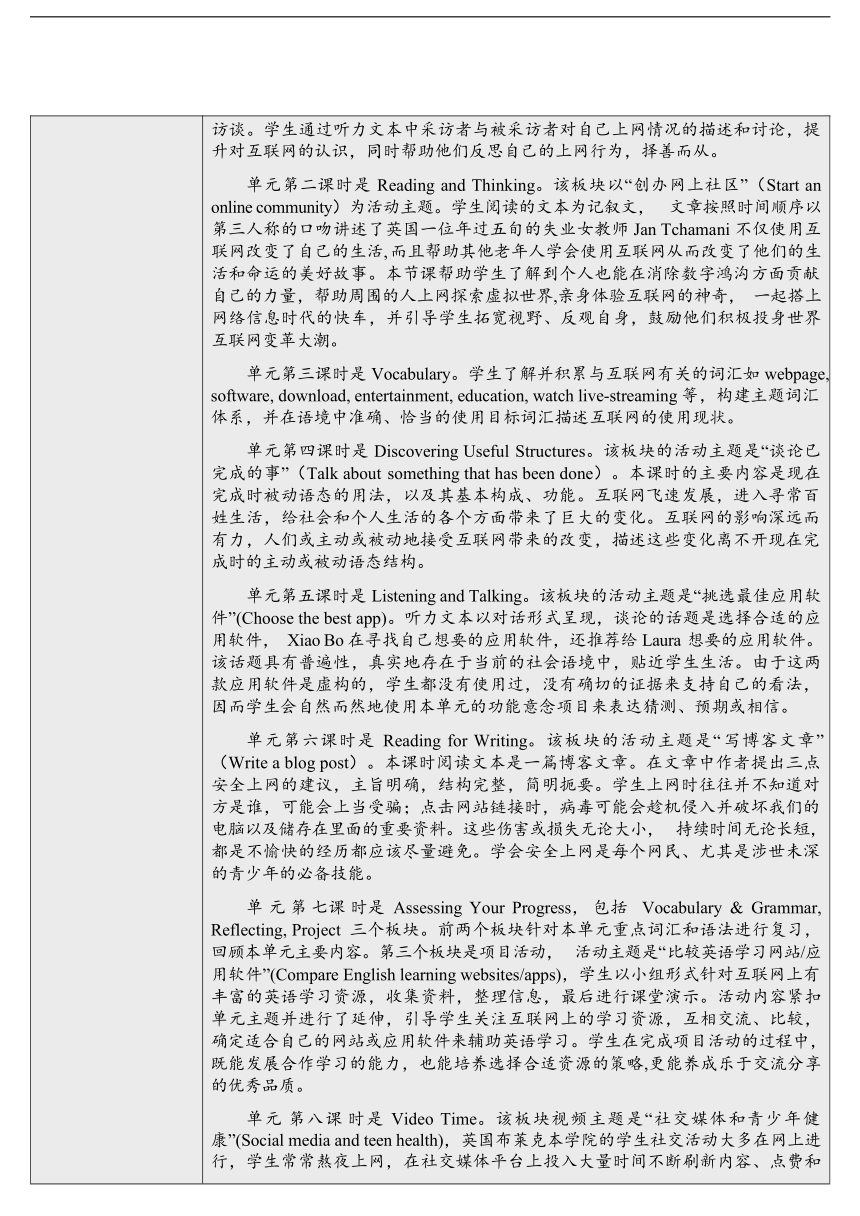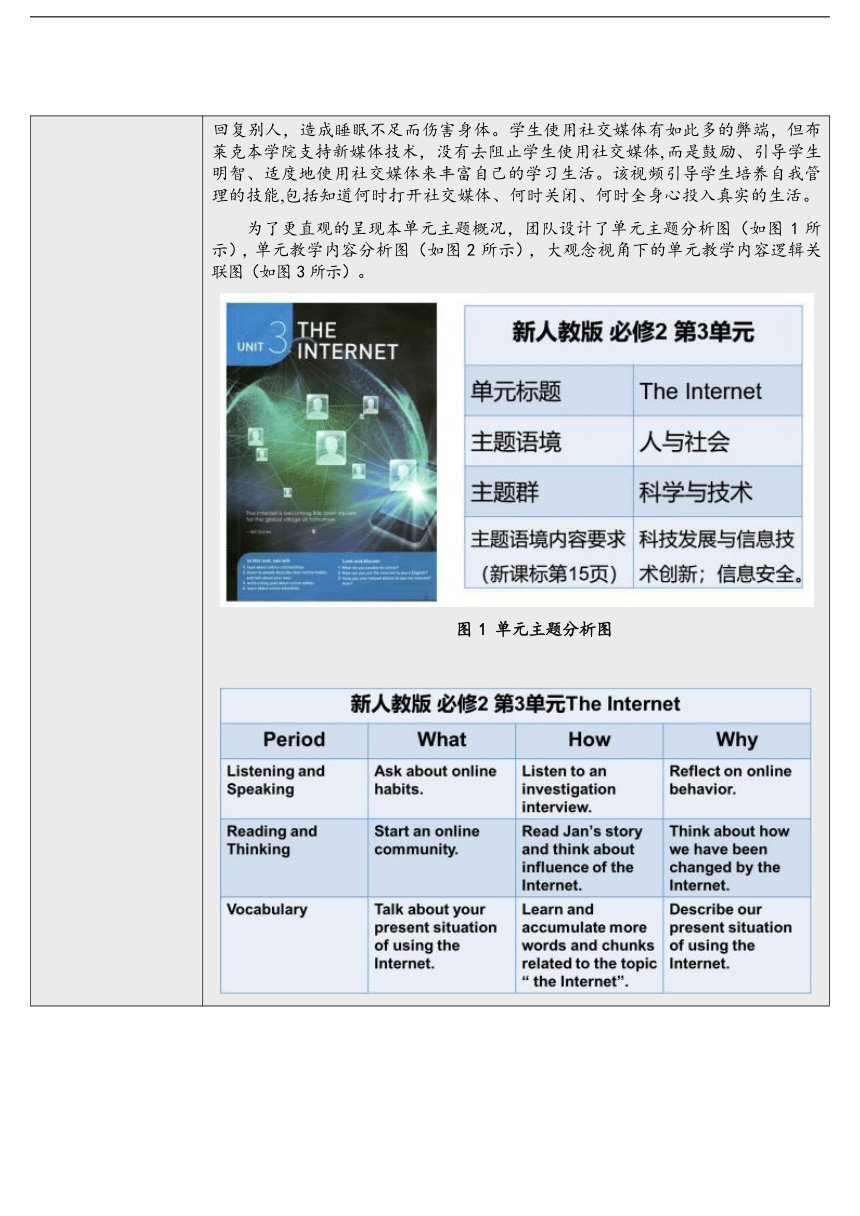人教版(2019)必修第二册Unit 3 The Internet 全单元教学设计(表格式)
文档属性
| 名称 | 人教版(2019)必修第二册Unit 3 The Internet 全单元教学设计(表格式) |

|
|
| 格式 | docx | ||
| 文件大小 | 1.4MB | ||
| 资源类型 | 教案 | ||
| 版本资源 | 人教版(2019) | ||
| 科目 | 英语 | ||
| 更新时间 | 2024-03-03 20:04:09 | ||
图片预览





文档简介
第一部分 The Internet 单元整体教学设计
单元基本信息
学科 英语 实施年级 高一
使用教材 人教版(2019)必修二
单元名称 Unit 3 The Internet
单元课时 8 课时
单元整体教学教学设计说明
基于主题意义探究的单元整体教学是指“教师基于课程标准,围绕特定主题,深入解读、分析整合 和重组教材等教学资源后,结合学习主体的需求,搭建起的一个由单元大主题统领、各语篇子主题相互 关联、逻辑清晰的完整教学单元,使教学能够围绕一个完整的单元主题设定目标,帮助学生在零散的知 识之间建立关联,形成结构,为推动整合性的学习创造可能,指向深度学习 (王蔷等, 2021)。 本教学设计围绕互联网这一单元主题,利用调 查类访谈、叙事文本、博客文章、音频、视频等多 模态语篇、创设真实情境, 激活学生已有知识和经验, 设计富有逻辑、层层递进的教— 学—评一体化活动, 引导学生阅读叙事文本、博客文章,使其理解相应 的文体特征和语言特点,并能在谈话中得体地表达 猜想和看法,写一篇关于网络安全的博客文章,使 学生在“ 互联网”主题语境中学习理解、应用实践和 迁移创新,逐步加深对互联网的认知,了解互联网 的给我们生活带来的巨大改变以其存在的弊病,培 养学生世界公民意识和地球村意识,并积极利用互 联网将自己与他人联系起来中,增强合理有效上网 的意识,训练批判性思维和提高创新思维能力。
引领性学习主题
1.主题名称 人与社会——互联网——共论网络行为,共享网络便利,共筑网络安全
2.主题概述 本单元以互联网为话题,这个由相互连接的计算机网络组成的全球系统,在 过去几十年里把世界连在一起, 并已成为全球工业和现代文化的支柱。在“人与社 会” 的主题之下, 学生们将了解同伴的网络使用习惯、网络社区、当代互联网技术 (如网络应用程序和博客)以及社交媒体及其对现代生活的影响。最后,学生将 进一步进入电子学习领域,并将学习分析相关网站和应用程序。希望学生能利用 本单元的信息来反思互联网是如何影响他们的生活和周围的世界,并体会互联网 的巨大力量,同时也要增强防护意识,安全上网,合理使用互联网。 首先, 开篇页主题图上这幅图片中纵横交织的线条象征着互联网的互通互联, 每个人形图标都代表一个人与网络上所有其他人相连;右下角的智能手机是当今 社会上网的主要方式,把散布在地球上各个角落的人紧密联系在一起。开篇页的 引言“The Internet is becoming the town square for the global village of tomorrow. — Bill Gates(因特网正成为明日地球村的闹市广场。—— 比尔 盖茨)”很好地诠释 了主题图的寓意:现实世界的闹市广场熙熙攘攘、人来人往,商品、服务和信息 在此集聚、流通、交换和分享,满足人们的物质生活和精神生活的需要。该名言 用闹市广场隐喻互联网,让学生更好地认识到互联网对于全人类的意义。 单元第一课时是 Listening and Speaking。该板块的活动主题是“调查上网习惯” (Ask about online habits)。听力文本是关于一个中学生互联网使用情况的调查类
访谈。学生通过听力文本中采访者与被采访者对自己上网情况的描述和讨论,提 升对互联网的认识,同时帮助他们反思自己的上网行为,择善而从。 单元第二课时是 Reading and Thinking。该板块以“创办网上社区”(Start an online community)为活动主题。学生阅读的文本为记叙文, 文章按照时间顺序以 第三人称的口吻讲述了英国一位年过五旬的失业女教师 Jan Tchamani 不仅使用互 联网改变了自己的生活, 而且帮助其他老年人学会使用互联网从而改变了他们的生 活和命运的美好故事。本节课帮助学生了解到个人也能在消除数字鸿沟方面贡献 自己的力量,帮助周围的人上网探索虚拟世界,亲身体验互联网的神奇, 一起搭上 网络信息时代的快车,并引导学生拓宽视野、反观自身,鼓励他们积极投身世界 互联网变革大潮。 单元第三课时是 Vocabulary。学生了解并积累与互联网有关的词汇如 webpage, software, download, entertainment, education, watch live-streaming 等,构建主题词汇 体系,并在语境中准确、恰当的使用目标词汇描述互联网的使用现状。 单元第四课时是 Discovering Useful Structures。该板块的活动主题是“谈论已 完成的事”(Talk about something that has been done)。本课时的主要内容是现在 完成时被动语态的用法,以及其基本构成、功能。互联网飞速发展,进入寻常百 姓生活,给社会和个人生活的各个方面带来了巨大的变化。互联网的影响深远而 有力,人们或主动或被动地接受互联网带来的改变,描述这些变化离不开现在完 成时的主动或被动语态结构。 单元第五课时是 Listening and Talking。该板块的活动主题是“挑选最佳应用软 件”(Choose the best app)。听力文本以对话形式呈现,谈论的话题是选择合适的应 用软件, Xiao Bo 在寻找自己想要的应用软件,还推荐给 Laura 想要的应用软件。 该话题具有普遍性,真实地存在于当前的社会语境中,贴近学生生活。由于这两 款应用软件是虚构的,学生都没有使用过,没有确切的证据来支持自己的看法, 因而学生会自然而然地使用本单元的功能意念项目来表达猜测、预期或相信。 单元第六课时是 Reading for Writing。该板块的活动主题是“ 写博客文章” (Write a blog post)。本课时阅读文本是一篇博客文章。在文章中作者提出三点 安全上网的建议,主旨明确,结构完整,简明扼要。学生上网时往往并不知道对 方是谁,可能会上当受骗;点击网站链接时,病毒可能会趁机侵入并破坏我们的 电脑以及储存在里面的重要资料。这些伤害或损失无论大小, 持续时间无论长短, 都是不愉快的经历都应该尽量避免。学会安全上网是每个网民、尤其是涉世未深 的青少年的必备技能。 单 元 第 七课 时是 Assessing Your Progress, 包括 Vocabulary & Grammar, Reflecting, Project 三个板块。前两个板块针对本单元重点词汇和语法进行复习, 回顾本单元主要内容。第三个板块是项目活动, 活动主题是“ 比较英语学习网站/应 用软件”(Compare English learning websites/apps),学生以小组形式针对互联网上有 丰富的英语学习资源,收集资料,整理信息,最后进行课堂演示。活动内容紧扣 单元主题并进行了延伸,引导学生关注互联网上的学习资源,互相交流、比较, 确定适合自己的网站或应用软件来辅助英语学习。学生在完成项目活动的过程中, 既能发展合作学习的能力,也能培养选择合适资源的策略,更能养成乐于交流分享 的优秀品质。 单元 第八课 时是 Video Time。该板块视频主题是“社交媒体和青少年健 康”(Social media and teen health),英国布莱克本学院的学生社交活动大多在网上进 行,学生常常熬夜上网,在社交媒体平台上投入大量时间不断刷新内容、点费和
回复别人,造成睡眠不足而伤害身体。学生使用社交媒体有如此多的弊端,但布 莱克本学院支持新媒体技术,没有去阻止学生使用社交媒体, 而是鼓励、引导学生 明智、适度地使用社交媒体来丰富自己的学习生活。该视频引导学生培养自我管 理的技能,包括知道何时打开社交媒体、何时关闭、何时全身心投入真实的生活。 为了更直观的呈现本单元主题概况,团队设计了单元主题分析图(如图 1 所 示),单元教学内容分析图(如图 2 所示), 大观念视角下的单元教学内容逻辑关 联图(如图 3 所示)。 图 1 单元主题分析图
图 2 单元教学内容分析图 图 3 大观念视角下的单元教学内容逻辑关联图
3.主题学情分析 第一,学生对于本单元主题互联网相当熟悉,但是他们对于如何利用互联网 提升自己和他人的学习及生活不够了解,同学之间对于线上学习应用程序的交流 也较少。不清楚互联网除了娱乐、获取资讯和与他人交流之外,可以从更多方面 来改善我们的生活。 第二,当代学生都有上网的习惯,但他们很少关注自己的上网习惯和其他同 学的上网习惯,对于上网习惯的好坏与否无法进行自我界定和掌控。 第三,学生虽然接触过博客,但是对该文体没有深入发掘,未尝试过书写英
文博客,需要进一步学习它们的语言特点和功能。 第四,学生的互联网相关的词汇量较为有限,还处于积累和获取阶段,虽然 已掌握一些可以用于谈论互联网用途的相关词汇, 但用英语去描述互联网的影响、 利弊还是有难度。 第五,学生在之前的学习已经接触过现在完成时被动语态的用法,主动语态 和被动语态表达的内容相同,但两个句子的主语不同,所要谈论的对象也不同。 学生尚不能灵活根据语言环境和表达选择合适的语态。 在以上基础上,团队基于核心素养教育理念,整合了单元主题学情分析,绘 制了核心素养视角下的主题学情分析图(如图 4 所示)。 图 4 核心素养视角下的主题学情分析图
素养导向的学习目标
4. 单元学习目标 与课时安排 单元教学目标 活动主题及课时
共论网 络行为 通过听力文本中对网络使用习惯的调查访 谈,反思自己的上网行为,借鉴他人良好的 上网习惯,戒除自己不良的上网行为。 Ask about online habits (Listening and Speaking) (听说: 一课时)
学习现在完成时被动语态的用法、及其基本 构成、功能,在学生熟练掌握现在完成时被 动语态的形式和意义的基础上,引导他们恰 当地使用现在完成时主动语态和被动语态去 构建有意义的语篇来描述互联网带来了巨大 的变化。 Talk about something that has been done (Discover useful structures) (语言运用: 一课时)
共享网 络便利 学 生 了解并积 累 与互联 网有 关 的词 汇如 webpage, software, download, entertainment, education, watch live-streaming 等,构建主题 词汇体系,并在语境中准确、恰当的使用目 标词汇描述互联网的使用现状。 Vocabulary (单元主题词汇教学: 一 课时)
了解失业女教师通过 互联网改变了自己及 Start an online community (Reading and Thinking)
他人的生活和命运的 美好故事的生活,揭 示了互联网的作用和 意义,让学生反思互 联网和自己的关系, 鼓励他们积极投身世 界互联网变革大潮塑 造正确的世界观、人 生观和价值观。 (读思: 一课时)
结合听力训练和口头 表达,谈论应用软件 赋予智能设备各种各 样的功能, 能够使用 本单元的功能意念项 目来表达对应用程序 的猜测、预期或相信, 选择好的应用程序。 Choose the best app (Listening and Talking) (听说: 一课时)
引导学生关注互联网 上的学习资源,互相 交流比较,确定适合 自己的网站或应用软 件来辅助英语学习。 Assessing Your Progress (自我评测: 一课时)
共筑网络安全 通过阅读一篇有关安 全上网建议的博客文 章, 了解博文的文体 特点,然后能写一篇 涉及互联网利弊的博 文,并在博文中给出 安全上网的建议。 Write a blog post (Reading for Writing) (读写: 一课时)
通过观看和思考视频 内容,让学生了解错 误使用社交媒体的弊 端,鼓励、引导学生 明智、适度地使用社 交媒体来丰富自己的 学习生活。 Social media and teen health (Video Time) (视听: 一课时)
挑战性学习任务
学习活动 《普通高中英语课程标准(2017 年版 2020 年修订)》提出了指向学科核心素养 发展的英语学习活动观,强调以学习活动为载体,发展学生核心素养,培育具有 中国情怀、国际视野和跨文化沟通能力的社会主义建设者和接班人。英语学习活 动观视角下的活动包含三类相互关联、层层递进的学习活动,即学习理解类、应 用实践类和迁移创新类活动(教育部, 2018)。 英语课程标准提出“英语学习活动观 ”,是希望通过强化课程内容与教学方式 的关联互动, 促进学生核心素养的发展、促进课程育人目标的落实。“英语学习活
动观 ”强调体验和实践, 强调“学用结合 ”和“为解决问题而教 ”,强调为学生的 素养发展和健康成长而教。 在此背景下,团队在设计教学活动时注重以主题为引领,并基于教材设计了 单元主题意义探究视角下的学习活动(如图 5 所示),这些活动以语篇为依托, 通 过学习理解、应用实践、迁移创新等三类相互关联的教学活动,引导学生在主题 意义探究过程中学习英语语言知识和文化知识,发展英语语言技能和学习策略, 同时运用所学英语知识、技能和策略,在学生自己的学习、生活中灵活运用英语 去获取信息、协助交际、帮助解决问题。 例如,在 Reading and Thinking 这一课时中,授课教师基于前一课时的主题 (online habits)为切入点,引导学生反思自己的上网习惯,启发他们思考网络给 我们生活带来的改变,从而引入本节课主题。然后,教师设计了学习理解活动以 帮助学生根据课文标题预测文本大意和作者的态度,使他们了解到关注标题是尽 快获取主旨大意的有效途径,培养了学生“Read headlines ”的阅读技能。教师再 通过问题链,引导学生深入阅读文本,帮助他们分析和梳理文本信息,形成思维 导图(应用实践类活动),让他们认识到互联网对整个社会的影响。接着, 学生读 思关于乌镇互联网大会的文章(迁移创新类活动),帮助学生拓宽思维, 开拓视野, 同时也让他们认识到互联网不仅给全世界带来变化, 也改变了我们的城市。最后, 学生反思自己和互联网的关系,这一环节不仅帮助学生从自身的角度深入思考人 们因互联网变得更强大这一主题,也为本单元后面的课时中讨论如何有效地使用 互联网奠定了基础。 再如, Vocabulary 课时的活动主题是“谈论你现阶段的互联网使用情况 ”。在 本课时中,学生通过讨论、总结、分享、角色扮演等活动方式对上网途径、互联 网对生活的改变以及上网习惯三个方面的词汇进行积累并运用。首先提出问题 (Jane 来华采访学生有关互联网使用情况),然后解决问题(积累与互联网使用情 况相关词汇), 最后呈现(运用所学词汇进行表达)。学生在解决问题的过程中, 了解了合成词、名词后缀以及根据上下文来猜词义等词汇学习策略,为今后的英 语词汇学习也奠定了很好的基础。 图 5 单元主题意义探究视角下的学习活动图
开放性学习环境
6.*开放性学习环境 在开放式学习环境中, 团队采用多种形式和手段组织了不同层次的教学活动。 团队在每节课中都利用了多种媒体技术组织教学,并采用新颖的课堂活动提升学 生的核心素养,有些教学活动甚至在教室外进行。 例如, 在本单元 Period 1 Listening and Speaking 课时中, 教师创设真实的语言 情境,以小组为单位开展活动,让学生化身为小记者对小组成员的上网习惯进行 采访并记录,最终形成采访报告。在采访的过程中,学生可运用目标语言或者开 放性的问题多角度的了解同伴的上网习惯。在展示采访报告中,学生亦可做出反 思或给出建设性意见,从而让学生在宽松,开放的学习小组活动中理解养成健康 的上网习惯的重要性。 再如, 在本单元 Period 7 Assess your progress 课前, 针对学生和老师在英语学 习中使用的英语 app,学生分组在校内进行调查(如图 6 所示),调查的形式是开 放的,可以是调查问卷,可以是采访或访谈等,并且学生可以用不同的形式对调 查结果进行总结, 并在课上分组进行展示。学生们做出了各种各样的 ppt,每个小 组代表完美展示了他们的调查结果(如图 9 所示)。在此过程中, 授课教师扮演着 教学活动的“旁观者 ”。为了更好的分享他们的劳动成果, 让更多英语学习者受益, 授课教师请他们写一篇“blog post ”,并在课后鼓励他们在校内或者互联网上分享。 整个教学流程都是以学生为主体,以活动为载体,展现出了学生不可估量的智慧 和创新能力,同学们在合作学习中学会了分享。 图 6 开放性学习环境示例(学生校内进行调查)
持续性学习评价
7.主题持续性评价 完整的教学活动包括教、学、评三个方面。“评 ”是教师依据教学目标确定评 价内容和评价标准, 通过组织和引导学生完成以评价目标为导向的多种评价活动, 以此监控学生的学习过程, 检测教与学的效果, 实现以评促学、以评促教(普通高 中英语课程标准(2017 年版 2020 年修订))。 在本单元教学设计中,教师将持续关注学生对本单元主题的掌握情况,并进 行评价。主题持续性评价包括了单元教学目标评价(如图 7 所示)、课时教学目标 评价(如图 8 所示)及课堂活动中学生学习成果的评价(如图 9 所示)。 另外,为了巩固所学,并提升学生对单元主题的掌握能力,团队还设计了单 元学案(详见附录)。 图 7 单元教学目标评价示例图
图 8 课时教学目标评价示例图 图 9 课堂活动中学生学习成果的评价
8. 单元作业设计 作业作为课堂教学的补充和延伸,在学生知识巩固、能力培养、思维提升等 方面发挥了重要的作用。“双减 ”政策的实施对作业的布置提出了更新、更高的要 求。团队基于单元整体教学设计,提出了单元作业的设计策略,通过主题引领、
任务驱动、多维评价的方式优化单元作业的设计, 使英语作业体现整体性、层次性、 差异性,实现减负提质的变化。本单元作业设计紧扣单元主题意义的探究,以调 查网络使用习惯、分析互联网利弊、合理使用互联网和构建网络空间命运共同体 为主线,设计了一系列具有科学性、趣味性、针对性和综合性的作业。 另外,为了巩固所学,并提升学生对单元主题的掌握能力,团队还设计了单 元学案(详见附录)。
图 10 单元作业设计图
第二部分 The Internet Listening and Talking
课时教学设计
第 5 课时 Listening and Talking
1.教材分析 What: The topic of the listening text is “Choose the best app”. Laura and Xiao Bo are talking about choosing apps and different functions. In the conversation, they express their predictions, guesses and beliefs for apps. Why: The purpose of the listening text is to help students to understand the basic characteristics and kinds of apps through common oral communication forms in daily life situations, inspire students to explore different functions of apps, advocate students to deeper understand apps and choose the best app. How: The text is presented in the form of a conversation. The language the speakers use to greet each other suggests they are familiar with each other. In the conversation, the two speakers use a lot of action verbs such as “suppose”, “believe”, “think”, “imagine” and modal verbs such as “might”, “could” and “would” to express predictions, guesses, and beliefs.
2.学情分析 This lesson is designed for the freshmen in senior high school. Through previous learning, students are quite familiar with the topic of the Internet, especially apps. However, they lack accurate cognition of different functions of apps and most students' cognition of choosing apps is unsystematic. So they might want to know how to identity the functions of apps and choose the best app. In this period, they will learn about how to express predictions, guesses and beliefs of choosing apps, design apps that need and choose the best app.
3.教学目标 By the end of this class, students will be able to 1. summarize and identify choices of apps of the speakers. 2. analyze and sum up the words and sentence structure to express predictions, guesses and beliefs and apply them in expressing themselves through talking. 3. share their daily use of apps, create apps they need and choose the best app. 4. acquire further understanding about apps, realize the importance of choosing good apps and form a positive attitude to the Internet.
4.*重点难点 Key Points 1. Lead students to summarize and identify choices of apps of the speakers. 2. Organize students to analyze and sum up the words and sentence structure to express predictions, guesses and beliefs and apply them in expressing themselves through talking.
Difficult Points How to organize students to apply the expressions of making predictions to share their daily use of apps, create apps they need and choose the best app.
教学目标 教学活动与步骤设计意图 评价要点 时间 与互 动模 式
To activate students ’ background knowledge about apps. Activity 1 Watch and answer 1. Look at the pictures, recall the sharing of apps in previous learning. 2. Watch a video and think of the choices of Chinese apps of some foreigners. Students are able to think about the role and functions of the apps based on pictures and the video. IW/ CW 3’
设计意图:To activate students’ prior knowledge and lead in the topic.
To summarize the choices of apps of the speakers. Activity 2 Listen to summarize Listen to the conversation and summarize the apps they want. Students are able to obtain and summarize main listening information. IW/ CW 3’
设计意图:To help students practise their listening skills, grasp the gist and summarize choices of apps of the speakers.
To identify predictions of the speakers and functions of the apps. Activity 3 Listen to identify 1. Read the listening skill - focus on key words and get the key information. 2. Listen again and identify whether the statements are true of false. 3. What do they think of the functions Students can obtain detailed listening information based on key words and make judgments. IW 4’
设计意图:To practise students' listening skills, develop their ability to obtain detailed information from listening materials to identify choices of
apps of the speakers .
To notice the sentences from the listening to express predictions, guesses and beliefs. Activity 4 Listen and discover 1. Tick the sentences mentioned in the conversation showing guesses, beliefs and predictions. 2. Listen to the conversation and check the answers. Students are able to notice the functional language in listening. IW/ CW 4’
设计意图:To lead students to predict, notice and find the target language structure in listening to show predictions, guesses and beliefs.
To analyze and sum up the words and sentence structure to express predictions, guesses and beliefs. Activity 5 Notice and summarize 1. Notice and circle the words used to express predictions, guesses and beliefs. 2. Sum up the sentence structure expressing predictions, guesses and beliefs. Students are able to recognize functional language and summarize their features. IW 5’
设计意图: 1. To lead students to analyze the features of target functional language of making predictions. 2. To equip students with expressions of making predictions and lay a foundation for talking.
1. To help students understand their tasks clearly. 2. To help students share their daily use of apps, create apps they need and choose the best app in real situation. 3. To guide students to apply what they have Activity 6 Survey and share 1. The school English club is going to hold activities. Watch the video and see what will happen. 2. Complete the survey. Students are able to express themselves in real life situations based on known target language and topics. IW/ PW/ GW 18’
learned to express themselves through talking individually and cooperatively. Share thoughts on the first set of questions individually. Discuss with a partner and share thoughts on the second set of questions. Work with group members and complete the last activity of the survey to design an app.
3. Choose the app represents the whole class to participate in the club's presentation and explains the reason.
设计意图:1. To help students share their daily use of apps, create apps they need and choose the best app in real situation. 2. To lead students to internalize knowledge learned in previous activities and apply it to new situations to express themselves through talking individually and cooperatively. 3. To guide students to attach importance to functions of apps and acquire further understanding about apps.
To help students acquire further understanding about apps, realize the importance of choosing good apps and form a positive attitude to the Internet. Activity 7 Think and summarize Think and summarize what a good app is and be aware of choosing the best app. Students can summarize the features of the apps and reflect on the importance of the Internet and choosing the best app. CW 2’
Realize the importance of the Internet and making choices.
设计意图:To help students acquire further understanding about apps, realize the importance of choosing good apps and form a positive attitude to the Internet.
To assess themselves from different aspects. Self-assessment Finish the self-assessment and reflect on the class. Students are able to assess their performances in this class according to the checklist. IW 1’
设计意图:To help students assess themselves from different aspects and evaluate what they have learned in class.
6.板书设计
7.作业布置 1. Explore more structures expressing guesses. 2. Discover an app that is widely used in your life and write an article to introduce it. 3. Visit the App Store to learn more about different apps. 设计意图:
1. To help students consolidate their understanding of the topic. 2. To encourage students to present what they have learned in a practical and meaningful way.
8.教学反思 First, Seven activities are designed according to three cognitive levels. Through the activities, students ’ core competence can be developed in every activity. Students are not taught, but guided and assisted to make discoveries in various student-centered activities. Additionally, with the integration of teaching, learning and assessment, students can obtain confidence and sense of achievement to explore the world bravely. The class promoted both teaching and learning by various assessments. Finally, at the end of the class, students achieved period objectives, which would eventually help students achieve the big idea of the whole unit. In summary, the whole class went smoothly with various activities and students’ performances, achieved period objectives which help explore the thematic meaning of the whole unit. Yet, more attention should be paid to students’ individualized differences both in cognition and ability, and design diverse activities and assignments to ensure everyone’s progress and make individualized development at the same time.
单元基本信息
学科 英语 实施年级 高一
使用教材 人教版(2019)必修二
单元名称 Unit 3 The Internet
单元课时 8 课时
单元整体教学教学设计说明
基于主题意义探究的单元整体教学是指“教师基于课程标准,围绕特定主题,深入解读、分析整合 和重组教材等教学资源后,结合学习主体的需求,搭建起的一个由单元大主题统领、各语篇子主题相互 关联、逻辑清晰的完整教学单元,使教学能够围绕一个完整的单元主题设定目标,帮助学生在零散的知 识之间建立关联,形成结构,为推动整合性的学习创造可能,指向深度学习 (王蔷等, 2021)。 本教学设计围绕互联网这一单元主题,利用调 查类访谈、叙事文本、博客文章、音频、视频等多 模态语篇、创设真实情境, 激活学生已有知识和经验, 设计富有逻辑、层层递进的教— 学—评一体化活动, 引导学生阅读叙事文本、博客文章,使其理解相应 的文体特征和语言特点,并能在谈话中得体地表达 猜想和看法,写一篇关于网络安全的博客文章,使 学生在“ 互联网”主题语境中学习理解、应用实践和 迁移创新,逐步加深对互联网的认知,了解互联网 的给我们生活带来的巨大改变以其存在的弊病,培 养学生世界公民意识和地球村意识,并积极利用互 联网将自己与他人联系起来中,增强合理有效上网 的意识,训练批判性思维和提高创新思维能力。
引领性学习主题
1.主题名称 人与社会——互联网——共论网络行为,共享网络便利,共筑网络安全
2.主题概述 本单元以互联网为话题,这个由相互连接的计算机网络组成的全球系统,在 过去几十年里把世界连在一起, 并已成为全球工业和现代文化的支柱。在“人与社 会” 的主题之下, 学生们将了解同伴的网络使用习惯、网络社区、当代互联网技术 (如网络应用程序和博客)以及社交媒体及其对现代生活的影响。最后,学生将 进一步进入电子学习领域,并将学习分析相关网站和应用程序。希望学生能利用 本单元的信息来反思互联网是如何影响他们的生活和周围的世界,并体会互联网 的巨大力量,同时也要增强防护意识,安全上网,合理使用互联网。 首先, 开篇页主题图上这幅图片中纵横交织的线条象征着互联网的互通互联, 每个人形图标都代表一个人与网络上所有其他人相连;右下角的智能手机是当今 社会上网的主要方式,把散布在地球上各个角落的人紧密联系在一起。开篇页的 引言“The Internet is becoming the town square for the global village of tomorrow. — Bill Gates(因特网正成为明日地球村的闹市广场。—— 比尔 盖茨)”很好地诠释 了主题图的寓意:现实世界的闹市广场熙熙攘攘、人来人往,商品、服务和信息 在此集聚、流通、交换和分享,满足人们的物质生活和精神生活的需要。该名言 用闹市广场隐喻互联网,让学生更好地认识到互联网对于全人类的意义。 单元第一课时是 Listening and Speaking。该板块的活动主题是“调查上网习惯” (Ask about online habits)。听力文本是关于一个中学生互联网使用情况的调查类
访谈。学生通过听力文本中采访者与被采访者对自己上网情况的描述和讨论,提 升对互联网的认识,同时帮助他们反思自己的上网行为,择善而从。 单元第二课时是 Reading and Thinking。该板块以“创办网上社区”(Start an online community)为活动主题。学生阅读的文本为记叙文, 文章按照时间顺序以 第三人称的口吻讲述了英国一位年过五旬的失业女教师 Jan Tchamani 不仅使用互 联网改变了自己的生活, 而且帮助其他老年人学会使用互联网从而改变了他们的生 活和命运的美好故事。本节课帮助学生了解到个人也能在消除数字鸿沟方面贡献 自己的力量,帮助周围的人上网探索虚拟世界,亲身体验互联网的神奇, 一起搭上 网络信息时代的快车,并引导学生拓宽视野、反观自身,鼓励他们积极投身世界 互联网变革大潮。 单元第三课时是 Vocabulary。学生了解并积累与互联网有关的词汇如 webpage, software, download, entertainment, education, watch live-streaming 等,构建主题词汇 体系,并在语境中准确、恰当的使用目标词汇描述互联网的使用现状。 单元第四课时是 Discovering Useful Structures。该板块的活动主题是“谈论已 完成的事”(Talk about something that has been done)。本课时的主要内容是现在 完成时被动语态的用法,以及其基本构成、功能。互联网飞速发展,进入寻常百 姓生活,给社会和个人生活的各个方面带来了巨大的变化。互联网的影响深远而 有力,人们或主动或被动地接受互联网带来的改变,描述这些变化离不开现在完 成时的主动或被动语态结构。 单元第五课时是 Listening and Talking。该板块的活动主题是“挑选最佳应用软 件”(Choose the best app)。听力文本以对话形式呈现,谈论的话题是选择合适的应 用软件, Xiao Bo 在寻找自己想要的应用软件,还推荐给 Laura 想要的应用软件。 该话题具有普遍性,真实地存在于当前的社会语境中,贴近学生生活。由于这两 款应用软件是虚构的,学生都没有使用过,没有确切的证据来支持自己的看法, 因而学生会自然而然地使用本单元的功能意念项目来表达猜测、预期或相信。 单元第六课时是 Reading for Writing。该板块的活动主题是“ 写博客文章” (Write a blog post)。本课时阅读文本是一篇博客文章。在文章中作者提出三点 安全上网的建议,主旨明确,结构完整,简明扼要。学生上网时往往并不知道对 方是谁,可能会上当受骗;点击网站链接时,病毒可能会趁机侵入并破坏我们的 电脑以及储存在里面的重要资料。这些伤害或损失无论大小, 持续时间无论长短, 都是不愉快的经历都应该尽量避免。学会安全上网是每个网民、尤其是涉世未深 的青少年的必备技能。 单 元 第 七课 时是 Assessing Your Progress, 包括 Vocabulary & Grammar, Reflecting, Project 三个板块。前两个板块针对本单元重点词汇和语法进行复习, 回顾本单元主要内容。第三个板块是项目活动, 活动主题是“ 比较英语学习网站/应 用软件”(Compare English learning websites/apps),学生以小组形式针对互联网上有 丰富的英语学习资源,收集资料,整理信息,最后进行课堂演示。活动内容紧扣 单元主题并进行了延伸,引导学生关注互联网上的学习资源,互相交流、比较, 确定适合自己的网站或应用软件来辅助英语学习。学生在完成项目活动的过程中, 既能发展合作学习的能力,也能培养选择合适资源的策略,更能养成乐于交流分享 的优秀品质。 单元 第八课 时是 Video Time。该板块视频主题是“社交媒体和青少年健 康”(Social media and teen health),英国布莱克本学院的学生社交活动大多在网上进 行,学生常常熬夜上网,在社交媒体平台上投入大量时间不断刷新内容、点费和
回复别人,造成睡眠不足而伤害身体。学生使用社交媒体有如此多的弊端,但布 莱克本学院支持新媒体技术,没有去阻止学生使用社交媒体, 而是鼓励、引导学生 明智、适度地使用社交媒体来丰富自己的学习生活。该视频引导学生培养自我管 理的技能,包括知道何时打开社交媒体、何时关闭、何时全身心投入真实的生活。 为了更直观的呈现本单元主题概况,团队设计了单元主题分析图(如图 1 所 示),单元教学内容分析图(如图 2 所示), 大观念视角下的单元教学内容逻辑关 联图(如图 3 所示)。 图 1 单元主题分析图
图 2 单元教学内容分析图 图 3 大观念视角下的单元教学内容逻辑关联图
3.主题学情分析 第一,学生对于本单元主题互联网相当熟悉,但是他们对于如何利用互联网 提升自己和他人的学习及生活不够了解,同学之间对于线上学习应用程序的交流 也较少。不清楚互联网除了娱乐、获取资讯和与他人交流之外,可以从更多方面 来改善我们的生活。 第二,当代学生都有上网的习惯,但他们很少关注自己的上网习惯和其他同 学的上网习惯,对于上网习惯的好坏与否无法进行自我界定和掌控。 第三,学生虽然接触过博客,但是对该文体没有深入发掘,未尝试过书写英
文博客,需要进一步学习它们的语言特点和功能。 第四,学生的互联网相关的词汇量较为有限,还处于积累和获取阶段,虽然 已掌握一些可以用于谈论互联网用途的相关词汇, 但用英语去描述互联网的影响、 利弊还是有难度。 第五,学生在之前的学习已经接触过现在完成时被动语态的用法,主动语态 和被动语态表达的内容相同,但两个句子的主语不同,所要谈论的对象也不同。 学生尚不能灵活根据语言环境和表达选择合适的语态。 在以上基础上,团队基于核心素养教育理念,整合了单元主题学情分析,绘 制了核心素养视角下的主题学情分析图(如图 4 所示)。 图 4 核心素养视角下的主题学情分析图
素养导向的学习目标
4. 单元学习目标 与课时安排 单元教学目标 活动主题及课时
共论网 络行为 通过听力文本中对网络使用习惯的调查访 谈,反思自己的上网行为,借鉴他人良好的 上网习惯,戒除自己不良的上网行为。 Ask about online habits (Listening and Speaking) (听说: 一课时)
学习现在完成时被动语态的用法、及其基本 构成、功能,在学生熟练掌握现在完成时被 动语态的形式和意义的基础上,引导他们恰 当地使用现在完成时主动语态和被动语态去 构建有意义的语篇来描述互联网带来了巨大 的变化。 Talk about something that has been done (Discover useful structures) (语言运用: 一课时)
共享网 络便利 学 生 了解并积 累 与互联 网有 关 的词 汇如 webpage, software, download, entertainment, education, watch live-streaming 等,构建主题 词汇体系,并在语境中准确、恰当的使用目 标词汇描述互联网的使用现状。 Vocabulary (单元主题词汇教学: 一 课时)
了解失业女教师通过 互联网改变了自己及 Start an online community (Reading and Thinking)
他人的生活和命运的 美好故事的生活,揭 示了互联网的作用和 意义,让学生反思互 联网和自己的关系, 鼓励他们积极投身世 界互联网变革大潮塑 造正确的世界观、人 生观和价值观。 (读思: 一课时)
结合听力训练和口头 表达,谈论应用软件 赋予智能设备各种各 样的功能, 能够使用 本单元的功能意念项 目来表达对应用程序 的猜测、预期或相信, 选择好的应用程序。 Choose the best app (Listening and Talking) (听说: 一课时)
引导学生关注互联网 上的学习资源,互相 交流比较,确定适合 自己的网站或应用软 件来辅助英语学习。 Assessing Your Progress (自我评测: 一课时)
共筑网络安全 通过阅读一篇有关安 全上网建议的博客文 章, 了解博文的文体 特点,然后能写一篇 涉及互联网利弊的博 文,并在博文中给出 安全上网的建议。 Write a blog post (Reading for Writing) (读写: 一课时)
通过观看和思考视频 内容,让学生了解错 误使用社交媒体的弊 端,鼓励、引导学生 明智、适度地使用社 交媒体来丰富自己的 学习生活。 Social media and teen health (Video Time) (视听: 一课时)
挑战性学习任务
学习活动 《普通高中英语课程标准(2017 年版 2020 年修订)》提出了指向学科核心素养 发展的英语学习活动观,强调以学习活动为载体,发展学生核心素养,培育具有 中国情怀、国际视野和跨文化沟通能力的社会主义建设者和接班人。英语学习活 动观视角下的活动包含三类相互关联、层层递进的学习活动,即学习理解类、应 用实践类和迁移创新类活动(教育部, 2018)。 英语课程标准提出“英语学习活动观 ”,是希望通过强化课程内容与教学方式 的关联互动, 促进学生核心素养的发展、促进课程育人目标的落实。“英语学习活
动观 ”强调体验和实践, 强调“学用结合 ”和“为解决问题而教 ”,强调为学生的 素养发展和健康成长而教。 在此背景下,团队在设计教学活动时注重以主题为引领,并基于教材设计了 单元主题意义探究视角下的学习活动(如图 5 所示),这些活动以语篇为依托, 通 过学习理解、应用实践、迁移创新等三类相互关联的教学活动,引导学生在主题 意义探究过程中学习英语语言知识和文化知识,发展英语语言技能和学习策略, 同时运用所学英语知识、技能和策略,在学生自己的学习、生活中灵活运用英语 去获取信息、协助交际、帮助解决问题。 例如,在 Reading and Thinking 这一课时中,授课教师基于前一课时的主题 (online habits)为切入点,引导学生反思自己的上网习惯,启发他们思考网络给 我们生活带来的改变,从而引入本节课主题。然后,教师设计了学习理解活动以 帮助学生根据课文标题预测文本大意和作者的态度,使他们了解到关注标题是尽 快获取主旨大意的有效途径,培养了学生“Read headlines ”的阅读技能。教师再 通过问题链,引导学生深入阅读文本,帮助他们分析和梳理文本信息,形成思维 导图(应用实践类活动),让他们认识到互联网对整个社会的影响。接着, 学生读 思关于乌镇互联网大会的文章(迁移创新类活动),帮助学生拓宽思维, 开拓视野, 同时也让他们认识到互联网不仅给全世界带来变化, 也改变了我们的城市。最后, 学生反思自己和互联网的关系,这一环节不仅帮助学生从自身的角度深入思考人 们因互联网变得更强大这一主题,也为本单元后面的课时中讨论如何有效地使用 互联网奠定了基础。 再如, Vocabulary 课时的活动主题是“谈论你现阶段的互联网使用情况 ”。在 本课时中,学生通过讨论、总结、分享、角色扮演等活动方式对上网途径、互联 网对生活的改变以及上网习惯三个方面的词汇进行积累并运用。首先提出问题 (Jane 来华采访学生有关互联网使用情况),然后解决问题(积累与互联网使用情 况相关词汇), 最后呈现(运用所学词汇进行表达)。学生在解决问题的过程中, 了解了合成词、名词后缀以及根据上下文来猜词义等词汇学习策略,为今后的英 语词汇学习也奠定了很好的基础。 图 5 单元主题意义探究视角下的学习活动图
开放性学习环境
6.*开放性学习环境 在开放式学习环境中, 团队采用多种形式和手段组织了不同层次的教学活动。 团队在每节课中都利用了多种媒体技术组织教学,并采用新颖的课堂活动提升学 生的核心素养,有些教学活动甚至在教室外进行。 例如, 在本单元 Period 1 Listening and Speaking 课时中, 教师创设真实的语言 情境,以小组为单位开展活动,让学生化身为小记者对小组成员的上网习惯进行 采访并记录,最终形成采访报告。在采访的过程中,学生可运用目标语言或者开 放性的问题多角度的了解同伴的上网习惯。在展示采访报告中,学生亦可做出反 思或给出建设性意见,从而让学生在宽松,开放的学习小组活动中理解养成健康 的上网习惯的重要性。 再如, 在本单元 Period 7 Assess your progress 课前, 针对学生和老师在英语学 习中使用的英语 app,学生分组在校内进行调查(如图 6 所示),调查的形式是开 放的,可以是调查问卷,可以是采访或访谈等,并且学生可以用不同的形式对调 查结果进行总结, 并在课上分组进行展示。学生们做出了各种各样的 ppt,每个小 组代表完美展示了他们的调查结果(如图 9 所示)。在此过程中, 授课教师扮演着 教学活动的“旁观者 ”。为了更好的分享他们的劳动成果, 让更多英语学习者受益, 授课教师请他们写一篇“blog post ”,并在课后鼓励他们在校内或者互联网上分享。 整个教学流程都是以学生为主体,以活动为载体,展现出了学生不可估量的智慧 和创新能力,同学们在合作学习中学会了分享。 图 6 开放性学习环境示例(学生校内进行调查)
持续性学习评价
7.主题持续性评价 完整的教学活动包括教、学、评三个方面。“评 ”是教师依据教学目标确定评 价内容和评价标准, 通过组织和引导学生完成以评价目标为导向的多种评价活动, 以此监控学生的学习过程, 检测教与学的效果, 实现以评促学、以评促教(普通高 中英语课程标准(2017 年版 2020 年修订))。 在本单元教学设计中,教师将持续关注学生对本单元主题的掌握情况,并进 行评价。主题持续性评价包括了单元教学目标评价(如图 7 所示)、课时教学目标 评价(如图 8 所示)及课堂活动中学生学习成果的评价(如图 9 所示)。 另外,为了巩固所学,并提升学生对单元主题的掌握能力,团队还设计了单 元学案(详见附录)。 图 7 单元教学目标评价示例图
图 8 课时教学目标评价示例图 图 9 课堂活动中学生学习成果的评价
8. 单元作业设计 作业作为课堂教学的补充和延伸,在学生知识巩固、能力培养、思维提升等 方面发挥了重要的作用。“双减 ”政策的实施对作业的布置提出了更新、更高的要 求。团队基于单元整体教学设计,提出了单元作业的设计策略,通过主题引领、
任务驱动、多维评价的方式优化单元作业的设计, 使英语作业体现整体性、层次性、 差异性,实现减负提质的变化。本单元作业设计紧扣单元主题意义的探究,以调 查网络使用习惯、分析互联网利弊、合理使用互联网和构建网络空间命运共同体 为主线,设计了一系列具有科学性、趣味性、针对性和综合性的作业。 另外,为了巩固所学,并提升学生对单元主题的掌握能力,团队还设计了单 元学案(详见附录)。
图 10 单元作业设计图
第二部分 The Internet Listening and Talking
课时教学设计
第 5 课时 Listening and Talking
1.教材分析 What: The topic of the listening text is “Choose the best app”. Laura and Xiao Bo are talking about choosing apps and different functions. In the conversation, they express their predictions, guesses and beliefs for apps. Why: The purpose of the listening text is to help students to understand the basic characteristics and kinds of apps through common oral communication forms in daily life situations, inspire students to explore different functions of apps, advocate students to deeper understand apps and choose the best app. How: The text is presented in the form of a conversation. The language the speakers use to greet each other suggests they are familiar with each other. In the conversation, the two speakers use a lot of action verbs such as “suppose”, “believe”, “think”, “imagine” and modal verbs such as “might”, “could” and “would” to express predictions, guesses, and beliefs.
2.学情分析 This lesson is designed for the freshmen in senior high school. Through previous learning, students are quite familiar with the topic of the Internet, especially apps. However, they lack accurate cognition of different functions of apps and most students' cognition of choosing apps is unsystematic. So they might want to know how to identity the functions of apps and choose the best app. In this period, they will learn about how to express predictions, guesses and beliefs of choosing apps, design apps that need and choose the best app.
3.教学目标 By the end of this class, students will be able to 1. summarize and identify choices of apps of the speakers. 2. analyze and sum up the words and sentence structure to express predictions, guesses and beliefs and apply them in expressing themselves through talking. 3. share their daily use of apps, create apps they need and choose the best app. 4. acquire further understanding about apps, realize the importance of choosing good apps and form a positive attitude to the Internet.
4.*重点难点 Key Points 1. Lead students to summarize and identify choices of apps of the speakers. 2. Organize students to analyze and sum up the words and sentence structure to express predictions, guesses and beliefs and apply them in expressing themselves through talking.
Difficult Points How to organize students to apply the expressions of making predictions to share their daily use of apps, create apps they need and choose the best app.
教学目标 教学活动与步骤设计意图 评价要点 时间 与互 动模 式
To activate students ’ background knowledge about apps. Activity 1 Watch and answer 1. Look at the pictures, recall the sharing of apps in previous learning. 2. Watch a video and think of the choices of Chinese apps of some foreigners. Students are able to think about the role and functions of the apps based on pictures and the video. IW/ CW 3’
设计意图:To activate students’ prior knowledge and lead in the topic.
To summarize the choices of apps of the speakers. Activity 2 Listen to summarize Listen to the conversation and summarize the apps they want. Students are able to obtain and summarize main listening information. IW/ CW 3’
设计意图:To help students practise their listening skills, grasp the gist and summarize choices of apps of the speakers.
To identify predictions of the speakers and functions of the apps. Activity 3 Listen to identify 1. Read the listening skill - focus on key words and get the key information. 2. Listen again and identify whether the statements are true of false. 3. What do they think of the functions Students can obtain detailed listening information based on key words and make judgments. IW 4’
设计意图:To practise students' listening skills, develop their ability to obtain detailed information from listening materials to identify choices of
apps of the speakers .
To notice the sentences from the listening to express predictions, guesses and beliefs. Activity 4 Listen and discover 1. Tick the sentences mentioned in the conversation showing guesses, beliefs and predictions. 2. Listen to the conversation and check the answers. Students are able to notice the functional language in listening. IW/ CW 4’
设计意图:To lead students to predict, notice and find the target language structure in listening to show predictions, guesses and beliefs.
To analyze and sum up the words and sentence structure to express predictions, guesses and beliefs. Activity 5 Notice and summarize 1. Notice and circle the words used to express predictions, guesses and beliefs. 2. Sum up the sentence structure expressing predictions, guesses and beliefs. Students are able to recognize functional language and summarize their features. IW 5’
设计意图: 1. To lead students to analyze the features of target functional language of making predictions. 2. To equip students with expressions of making predictions and lay a foundation for talking.
1. To help students understand their tasks clearly. 2. To help students share their daily use of apps, create apps they need and choose the best app in real situation. 3. To guide students to apply what they have Activity 6 Survey and share 1. The school English club is going to hold activities. Watch the video and see what will happen. 2. Complete the survey. Students are able to express themselves in real life situations based on known target language and topics. IW/ PW/ GW 18’
learned to express themselves through talking individually and cooperatively. Share thoughts on the first set of questions individually. Discuss with a partner and share thoughts on the second set of questions. Work with group members and complete the last activity of the survey to design an app.
3. Choose the app represents the whole class to participate in the club's presentation and explains the reason.
设计意图:1. To help students share their daily use of apps, create apps they need and choose the best app in real situation. 2. To lead students to internalize knowledge learned in previous activities and apply it to new situations to express themselves through talking individually and cooperatively. 3. To guide students to attach importance to functions of apps and acquire further understanding about apps.
To help students acquire further understanding about apps, realize the importance of choosing good apps and form a positive attitude to the Internet. Activity 7 Think and summarize Think and summarize what a good app is and be aware of choosing the best app. Students can summarize the features of the apps and reflect on the importance of the Internet and choosing the best app. CW 2’
Realize the importance of the Internet and making choices.
设计意图:To help students acquire further understanding about apps, realize the importance of choosing good apps and form a positive attitude to the Internet.
To assess themselves from different aspects. Self-assessment Finish the self-assessment and reflect on the class. Students are able to assess their performances in this class according to the checklist. IW 1’
设计意图:To help students assess themselves from different aspects and evaluate what they have learned in class.
6.板书设计
7.作业布置 1. Explore more structures expressing guesses. 2. Discover an app that is widely used in your life and write an article to introduce it. 3. Visit the App Store to learn more about different apps. 设计意图:
1. To help students consolidate their understanding of the topic. 2. To encourage students to present what they have learned in a practical and meaningful way.
8.教学反思 First, Seven activities are designed according to three cognitive levels. Through the activities, students ’ core competence can be developed in every activity. Students are not taught, but guided and assisted to make discoveries in various student-centered activities. Additionally, with the integration of teaching, learning and assessment, students can obtain confidence and sense of achievement to explore the world bravely. The class promoted both teaching and learning by various assessments. Finally, at the end of the class, students achieved period objectives, which would eventually help students achieve the big idea of the whole unit. In summary, the whole class went smoothly with various activities and students’ performances, achieved period objectives which help explore the thematic meaning of the whole unit. Yet, more attention should be paid to students’ individualized differences both in cognition and ability, and design diverse activities and assignments to ensure everyone’s progress and make individualized development at the same time.
